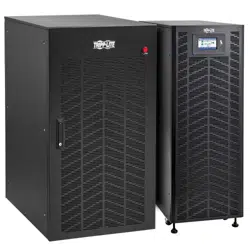Loading ...
Loading ...
Loading ...

77
7. Storage and Maintenance
7.1 Storage
The UPS must be stored in a clean, secure environment with a temperature less than 104°F (40°C) and a relative
humidity of less than 90% (non-condensing). Store the UPS in its original shipping container if possible. If installation
occurs more than 6 months after you receive the UPS system, recharge the batteries for at least 24 hours prior to use.
Do not rely on the UPS to provide backup power to connected equipment until the batteries are fully charged.
Note: If the UPS system remains o for an extended period of time, it should be turned on periodically to allow the batteries to recharge.
The UPS system should be turned on and the batteries should be recharged at least one uninterrupted 24-hour period every 3 months.
Failure to recharge the batteries periodically may cause irreversible battery damage.
7.2 Maintenance
We recommend annual preventive maintenance be performed on this product to ensure reliability and longevity.
Certied technicians are required to perform startup, preventive maintenance and repairs to validate all warranties.
Contact your local representative for more information.
General UPS and Battery Maintenance
The area around the UPS must be kept clean and dust-free.
For full battery life, keep the UPS at an ambient temperature of 77°F (25°C).
Note: Service life varies, depending on the frequency of usage and ambient temperature. Batteries used beyond expected service life will
often have severely reduced runtimes. Replace batteries at least every 5 years to keep the unit running at peak eciency.
• The UPS system operates with hazardous voltage. Repairs should be performed only by certied technicians.
• Even after the unit is disconnected from the mains, potentially dangerous components inside the UPS system are still
connected to the battery packs.
• Before carrying out any kind of service and/or maintenance, disconnect the batteries and verify no current is present
and no hazardous voltage exists in the terminals of high-capability capacitors, such as BUS-capacitors.
• Only qualied technicians taking the required precautionary measures may replace batteries and supervise
operations. Unauthorized persons should not perform battery maintenance.
• Verify no voltage between the battery terminals and the ground is present before maintenance or repair. The battery
circuit is not isolated from the input voltage. Hazardous voltages may occur between the battery terminals and the
ground.
• Batteries may cause electric shock and have a high short-circuit current. Remove all wristwatches, rings and other
metal personal objects before maintenance or repair, and use only tools with insulated grips and handles for
maintenance or repair.
• When replacing the batteries, install the same number, type and battery capacity.
• Do not attempt to dispose of batteries by burning them. This could cause a battery explosion. Batteries must be
appropriately disposed of according to local regulations.
• Do not open or destroy batteries. Escaping electrolytes may be toxic and can cause injury to the skin and eyes.
• To avoid re hazards, replace the fuse only with the same type and amperage.
• Do not disassemble the UPS system.
Loading ...
Loading ...
Loading ...
